Do you see a mismatch between an owner's statement and their portfolio ledger? This article explains the suppressed fee balance mismatch diagnostic and how to fix these mismatches.
This diagnostic simplifies the process of identifying instances where a property manager has either overcharged or undercharged an owner (unit) a suppressed fee by making it more accessible.
A suppressed fee is an additional fee that the Property Management company collects that is hidden from the owner. Here is how the process typically works:
- First, a charge is added to a lease using a GL/COA suppressed account.
- The tenant pays for this charge.
- Once the tenant pays for the charge, it shows as a suppressed increase on the portfolio ledger
- When posting management fees, the owner (unit) is billed for the same amount as the suppressed fee.
- The bill is paid by the owner (unit)
- Once the bill is paid by the owner (unit), it shows as a suppressed decrease on the portfolio ledger
Following the steps above ensures that the suppressed fee is properly collected by the property management company and no mismatch occurs, thus creating a balanced ($0.00) suppressed fee GL /COA.
- It is important to note that there can be a few issues that arise in this process, which can result in a suppressed fee mismatch. Three common scenarios can cause such a mismatch.
- The tenant pays for a suppressed lease charge, and you collect the suppressed fees from the owner (unit) for that charge. Later, the tenant's payment is returned. The return causes the lease charge to now be unpaid by the tenant, but you still billed the owner for that suppressed charge. The owner (unit) paid this suppressed fee that was meant to be paid by the lease charge. As a result, the owner will see a higher amount of funds than they actually have.
(Please view the negative section of this article to correct this first scenario.) -
The second scenario is similar, where a tenant pays for a suppressed lease charge, and you collect the suppressed fees from the owner (unit) for that charge. Later, you or a team member goes to the lease and voids that lease charge. If this occurs, you will have the same scenario where the owner is paying for a bill that is suppressed. As a result, the owner will see a higher amount of funds than they actually have.
(Please view the negative section of this article to correct this second scenario.)
- The third most common scenario is if a tenant pays for a suppressed lease charge and the suppressed fees are not collected by the property management company. As a result, the owner will see a lower amount of funds than they actually received.
(Please view the positive section of this article to correct this third scenario.)
- Rentvine has a suppressed fee balance mismatch diagnostic that makes it easy to identify when the scenarios above happen and makes it easy to correct. To get to this diagnostic, click on the Accounting tab in the navigation menu and then Diagnostics. In here, you will be able to scroll down until you see the diagnostic for "Suppressed Fee Balance Mismatch".
We highly recommend you come in and check this diagnostic after you have collected your additional suppressed management fees and just before you pay your owners, so you can check for any mismatches and make the proper corrections before paying your owners. We recommend checking it once per week.
It is always best practice to post and collect all management fees (Base Fees + Additional Fees) before paying owners. Make sure to collect management fees once again at the end of the month.
If you have any mismatches, they will appear here. You will be able to see the property/unit this occurred on, the GL/COA account that the mismatch is on, and the balance. Note that the balance will either be a positive amount or a negative amount.
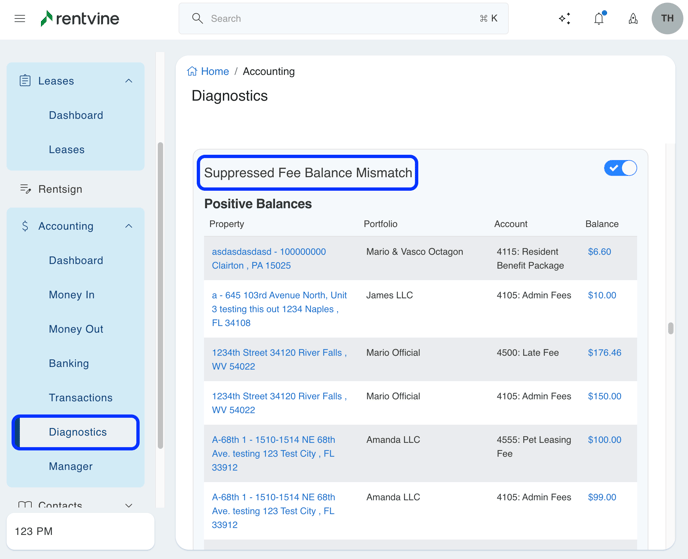
- If you click on the amount, it will run a general ledger report for you automatically and give you a breakdown of what is happening with that GL/COA account for troubleshooting purposes.

- The Suppressed Fee Balance Mismatch diagnostic shows a positive number or a negative number. These are two separate scenarios and will need different steps to be corrected. A negative amount will usually be the result of scenarios 1 & 2 mentioned at the beginning of this article, while a positive amount will usually be the result of scenario 3.
Correcting a Negative Amount
- If you see a negative amount in the mismatch, it means the owner was billed and paid for more than they actually owe. As a result, the owner will see a higher amount of funds than they actually have, and are owed money from the property management company. There are a few ways to correct the mismatch:
It is important to pick only one of the options to make the correction.
Option 1
- The most common way to correct this is to do a full, immediate refund to instantly fix the mismatch. To do this, click on either the Quick Actions, then Record Other Receipt or Accounting tab, click the Money In tab, click the green actions button, and click Record Other Receipt.
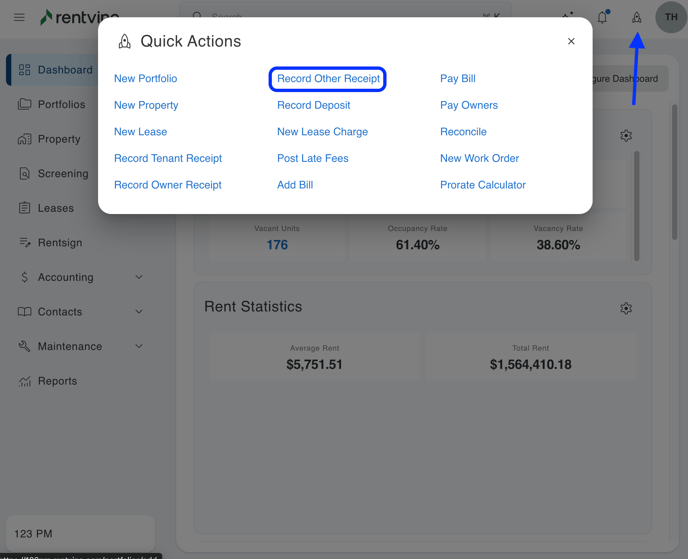
- In this screen, you will fill this out as follows:
- Apply to(Ledger)- This will need to be on the unit this occurred on so it still shows as suppressed. Do NOT select the portfolio, it is critical to make sure to select the UNIT


- Received From- Type in the name of your property management company here.
- Amount Received- This will be the total amount you need to refund the owner.
- Income Account- Select the suppressed GL/COA account that has the mismatch.
- Receipt Date- This will be the date this is given back to the owner
- Reference- Enter text that identifies the transaction, I.e, check number or transaction ID
- Description - Enter text that describes the transaction.
- Bank Account- Select the bank account used as the operating account on that portfolio's posting setting.
- Payment Type - Select the type of payment. You can select Other if you are not sure.
- Apply to(Ledger)- This will need to be on the unit this occurred on so it still shows as suppressed. Do NOT select the portfolio, it is critical to make sure to select the UNIT

-
- Click Save when complete.
This will balance out the suppressed fee mismatch.
Please note that if you choose this method, you will need to transfer the money in real life from your company's operating business bank account to your operating trust bank account. Be sure to record the deposit once it has been transferred.
Option 2
- If the mismatch happened within the current or prior period, go to the post management fees section and select the applicable period. You will now see the same unit that has a mismatch will show here. It will have an "amount to credit". Select the unit and proceed with posting it. Posting it will create a credit to the owner from the property management company. The credit can then be used to fully or partially pay for any other unpaid bills that the owner(unit) owes the property management company. The mismatch will be fixed when the credit is used to pay for a bill.
If you decided to go with Option 1 by recording an Other Payment, DO NOT POST the credit from the Post Management Fees section. Simply ignore it.
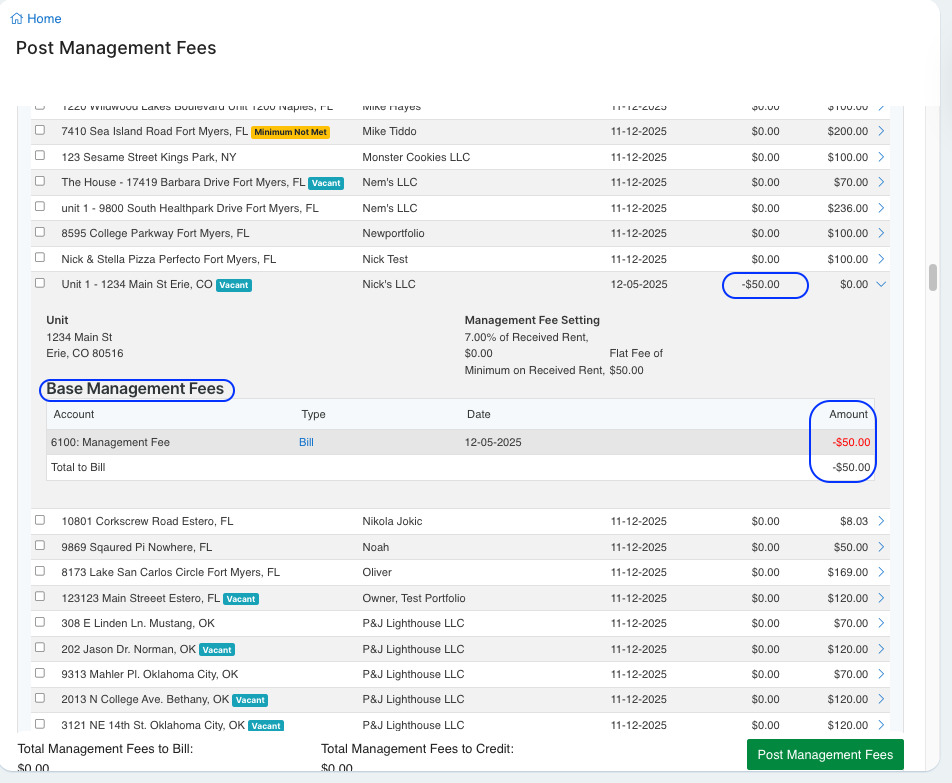
Please note that this will not immediately affect the portfolio ledger or fix the mismatch. The mismatch will be fixed when the credit is used to pay other or future bills that are owed by the owner (unit). When you go to the pay bills page, make sure to apply the credit(s) to those bills.
- Once all of those credits are allocated to other or future bills owed by that owner to the PM company, it will eventually fix the mismatch. Here is a link to an article on how to apply those credits on the pay bills page (You will find it on step 3 of this article): Apply Credits.
Option 3
- If the mismatch happened outside of the current or prior period, you can give a credit to the owner for the balance amount shown on the diagnostic page. To add a credit, you can go to Accounting> Money Out> Green Actions> Add Credit.
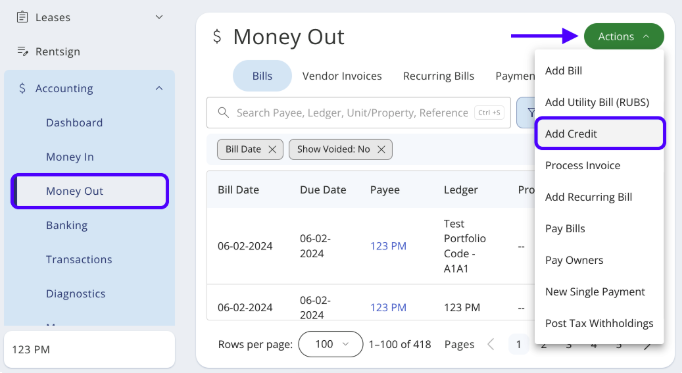
- In here, you will see the following fields to fill out:
- Credit From- You will choose your property management company here.
- Date Posted- The date you recorded this credit.
- Credit to- Apply this to the unit where the mismatch occurred on so this stays suppressed.
- Account- Choose the GL/COA account the suppressed fee mismatch occurred on.
- Amount- The full amount of the mismatch.
- Description- What this credit is for.
- Reference- Any additional information you would like to add.
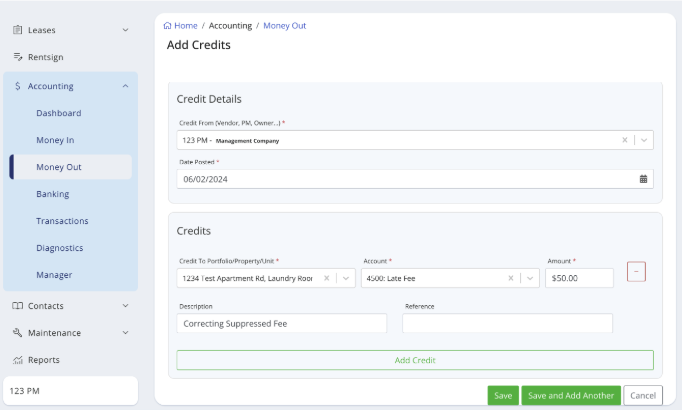
Please note that this will not immediately affect the portfolio ledger or fix the mismatch. The mismatch will be fixed when the credit is used to pay other or future bills that are owed by the owner (unit). When you go to the pay bills page, make sure to apply the credit(s) to those bills.
- Once all of those credits are allocated to other or future bills owed by that owner to the PM company, it will eventually fix the mismatch. Here is a link to an article on how to apply those credits on the pay bills page (You will find it on step 3 of this article): Apply Credits.
- Above were the 3 options you have to correct a suppressed fee mismatch that is showing a negative amount. The next section will show how to correct a mismatch that is showing a positive amount.
Correcting a Positive Amount
- If you see a positive amount on the suppressed fee mismatch diagnostic, this means that the tenant made a payment for a suppressed fee, but the property management company did not collect the suppressed fee from the owner (unit). The PM company will need to collect this money from the owner. There are a couple of options you have to do this:
Option 1
- If the mismatch happened within the current period or the previous period, use this option. If this is the case, go to Accounting> Manager. Go through the post management fees process and search for the unit that has the mismatch. If it shows that the suppressed fees need to be posted, go ahead and post (bill) the suppressed fee and then pay the bill that is created. Once the bill is paid, the mismatch will be corrected.

If the post management fee process shows that the unit does not have any suppressed fees to post, it's possible that a bill has already been created for the suppressed fee but has not been paid (collected) yet. Go to the Money Out / Bills tab and check to see if you have any unpaid bills from the owner (unit) for the suppressed fee GL/COA. If you do, pay the bill, and it will correct the mismatch.
Option 2
- If the mismatch happened outside of the current or previous period, you will have to manually record the bill to the owner (unit) for that suppressed fee and pay it. To do this, you can either go into the Quick Actions> Add Bill or from Accounting> Money Out> Green Actions> Add Bill.
- In here, you will see the following fields to fill out:
- Payee- You will put your property management company here.
- Bill Date- Select today's date.
- Date Due- You can put the same date this occurred in here.
- Invoice #/Reference #- Any reference that you want, if applicable.
- Payment Memo- Enter if applicable.
- Paid By- Be sure to select the unit in this field to make sure it is suppressed. Do not select the portfolio
- Account- You will choose the same suppressed GL / COA that the mismatch occurred on.
- Amount- This will be the amount you see on the suppressed fee mismatch diagnostic.
- Description- Any details you want to remember why this was recorded.
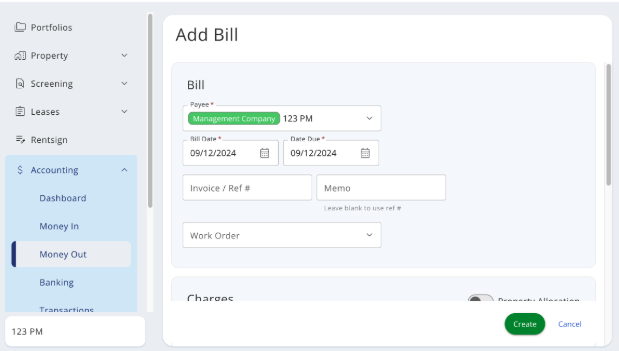
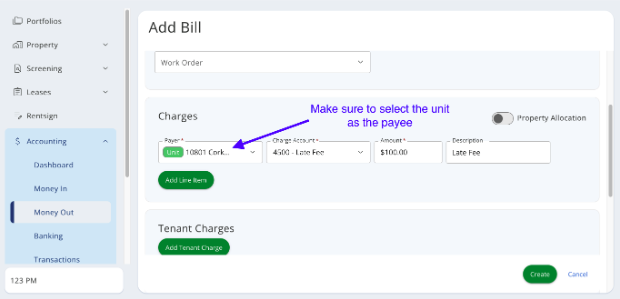
Please note that it is necessary to select the unit and NOT the portfolio. If the unit is not selected, then the suppressed fee mismatch will not be corrected. This is because the suppression is at the unit level, and if the portfolio is selected, it will skip over that suppression.


- Pay the Bill
Once this bill is paid, the mismatch will be corrected.
A reminder again to check this diagnostic at least once per week.
